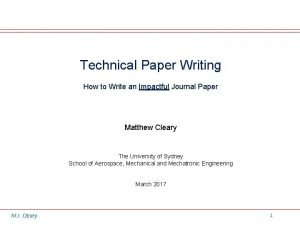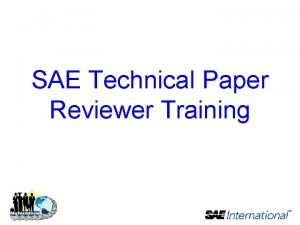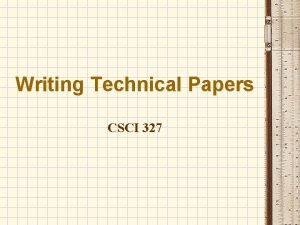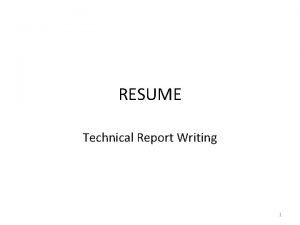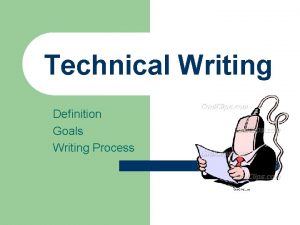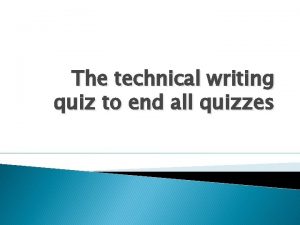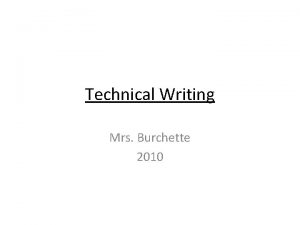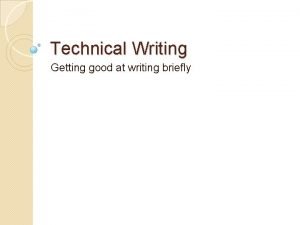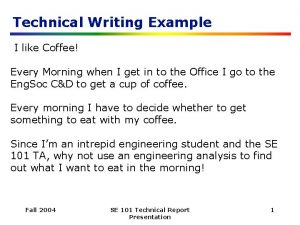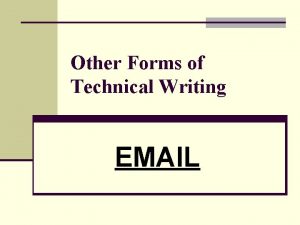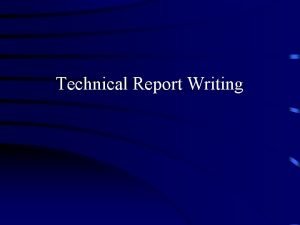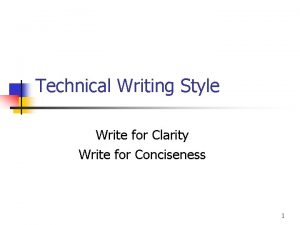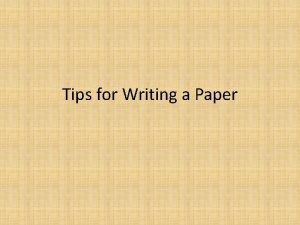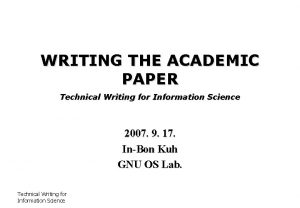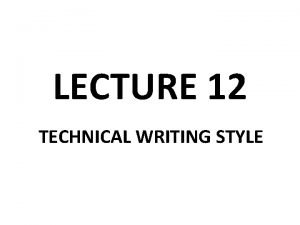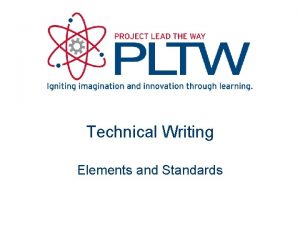Technical Paper Writing How to Write an Impactful












- Slides: 12

Technical Paper Writing How to Write an Impactful Journal Paper Matthew Cleary The University of Sydney School of Aerospace, Mechanical and Mechatronic Engineering March 2017 M. J. Cleary 1

Outline 1. Selecting a journal 2. Title of the paper 3. Structure of the paper 4. Figures 5. Writing style 6. Internal and external peer review M. J. Cleary 2

1. Selecting a Journal Golden Rule - quality rather than quantity. How do we know the quality of a journal? • What others tell us. • Prestige. • Indices and rankings. Journal metrics: https: //en. wikipedia. org/wiki/Journal_ranking#Measures Let’s look at impact factor (IF), Eigenfactor score, SCImago Journal Rank (SJR), Journal cited half-life, Journal Citation Reports (JCR), ARWU. M. J. Cleary 3

1. Selecting a Journal M. J. Cleary 4

1. Selecting a Journal Eigenfactor Score Similar to IF, but incoming citations are weighted according to the quality of the citing journal. Nature (1. 44256), J. Fluid Mech. (0. 05256), Compos. Sci. Technol. (0. 02303). SCImago Journal Rank (SJR) An extension of the Eigenfactor score. Iterative procedure where prestige of journals is determined until a steady-state is reached. Nature (21. 936), J. Fluid Mech. (1. 45), Compos. Sci. Technol. (1. 512). M. J. Cleary 5

1. Selecting a Journal Cited Half-Life The median age of the articles that were cited in the year. Half the journal’s cited articles were published more recently than the cited half-life. Nature (> 10 years), J. Fluid Mech. (> 10 years), Compos. Sci. Technol. (8. 3 years). Lower or higher value does not, in itself, indicate quality but it gives you an indication of its purpose (e. g. rapid communication of new ideas versus deep research) M. J. Cleary 6

1. Selecting a Journal How do we get all this data? Journal Citation Reports Most of the metrics mentioned above (plus a number of others) are available on the Journal Citation Reports. A yearly report. Available by through the library (institutional subscription). Academic Ranking of World Universities (ARWU) Previously Shanghai Ranking. Established 2003. Rankings in each field (e. g. ENG or SCI) based on number of journal papers in the ISI Top 20%. Google search USyd journal finder. M. J. Cleary 7

2. Title of the Paper How do you search the literature? (Consider whether you have different strategies for familiar and unfamiliar topics. ) Think about the topic on which you might write your next journal paper. Can you come up with a title for it? Share it with your neighbour. M. J. Cleary 8

3. Structure of the Paper Think about a few of the papers you have read recently. How many times did you have to read them before you understood them? Do you understand them now? What was the obstacle before? Could the authors have made it easier to understand? Think again about your next journal paper. Write down the section and, maybe, subsection headings. Think about it from the perspective of a time-poor reader. Share it with your neighbour. M. J. Cleary 9

4. Figures Think about the last time you searched the literature. After the title, what do you look for next before deciding whether to invest the effort into reading it in full? Were the figures helpful by themselves? How could they have been improved. Think again about your next journal paper. Sketch Figure 1 from that paper. Include a legend a caption. Share it with your neighbour. M. J. Cleary 10

5. Writing Style There are different writing styles, each can be useful and each can cause problems: • • • verbose (informative, boring) terse (quick read, missing pieces) helpful (good reference, lacks impact) erudite (convincing, arrogant) … Which one is most appropriate? For that paper? Consult your co-authors. Discuss it with your supervisor. M. J. Cleary 11

6. Internal & External Peer Review Golden Rule – do not take criticism personally. Internal peer review (more correctly called collaboration): • Discuss journal selection, title, structure, figures, style with your co-authors before doing all the writing. • Give your co-authors (especially busy ones) a draft that is already in very good shape. • It is better to be critcised internally than have a paper rejected by external reviewers. External peer review: • Take your time. Be polite. • Who will read your responses? The editor only, or the reviewer and the editor? M. J. Cleary 12
 How to write a technical paper
How to write a technical paper What is technical/academic writing
What is technical/academic writing Sae technical papers
Sae technical papers Technical paper outline
Technical paper outline English general paper paper 2 comprehension
English general paper paper 2 comprehension Aice general paper hand approach
Aice general paper hand approach Report writing skills resume
Report writing skills resume Technical writing
Technical writing Technical writing quiz
Technical writing quiz Vocabulary of technical writing
Vocabulary of technical writing Characteristics of technical writing
Characteristics of technical writing Technical report writing examples
Technical report writing examples Abc format technical writing
Abc format technical writing
